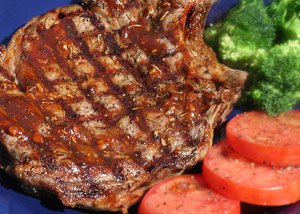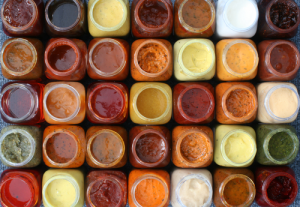By Rick Browne, Ph.B.
“It’s the sauce, man, it’s the sauce!”Recipes: Dracula’s Blood Orange Sauce Key West Citrus SauceBeer Butte Ranch SauceHorsey Sauce With a BiteCatfish BBQ Sauce (Marinade) |
Ah, the essence of barbecue. The glorious thickened liquid (sometimes not-so-thickened) that we gleefully baste, mop and slop with. The delicious mixture we dip, dab and dribble over our meat. And the fragrant, flavorful concoctions we brush on, marinate and slather over our fowl. Oh yeah, fish get their own stuff to swim in too—while they’re being broiled, that is!
 Sauce. To be specific, barbecue sauce. At the grocery store they come in all shapes and sizes. You have your garlic BBQ sauce, your honey-garlic BBQ sauce, your teriyaki-garlic BBQ sauce, and even your garlic-garlic BBQ sauce. Colorful, ergonomically- and aesthetically-designed bottles of magic elixir that we buy by the gallon give our BBQ’ed creations that final touch of majesty.
Sauce. To be specific, barbecue sauce. At the grocery store they come in all shapes and sizes. You have your garlic BBQ sauce, your honey-garlic BBQ sauce, your teriyaki-garlic BBQ sauce, and even your garlic-garlic BBQ sauce. Colorful, ergonomically- and aesthetically-designed bottles of magic elixir that we buy by the gallon give our BBQ’ed creations that final touch of majesty.
In fact, on America’s supermarket shelves you have more than 2,500 commercially bottled sauces available to take home. That’s about 1,996 tomato-, vinegar- and sugar-based sauces, most using (you guessed it) garlic, and almost seasoned with salt and pepper.
The other four sauces use the same ingredients, but add special items to make them “different:” ingredients like Hawaiian lotus position-blossom honey, Tasmanian pink marjoram, freeze-dried Ethiopian cassava root, and Lower Congo River essence of desiccated three-week old shrimp.
By far the greatest majority of store-bought BBQ sauces are pretty much the same. You start out with your tomato sauce, add sugar, add salt, add sugar, add pepper, add sugar, add garlic, add sugar, and, if you’re really daring, add red pepper.
But how, you ask plaintively, do you find the kind of yellow sauce that you dripped on your new shirt in Columbus, Georgia, when you went on the picnic with Uncle Harold and Aunt Rhoda, or that black stuff they dipped their lamb in when you ate over to cousins Jimmy and Lorraine’s in Paducah, Kentucky last May?
Well folks, this may come as a shock, but perhaps you already know the answer. You can make your own sauce! Right ‘chere in your own kitchen. Zounds, what a concept.
You can, of course use tomato sauce, sugar, salt, sugar, pepper, sugar, etc., or you can go out and invent something that suits your own tastes. Zounds again! Actually zounds like a good idea.
Sauces share the rich heritage of the places they came from—Georgia mustard sauce, Kentucky black mutton sauce, Kansas City-style sauce, and even Carolina vinegar sauce. Plus I’m gonna introduce you to a few new sauces keyed to “newly discovered” barbecue regions. First I’ll talk about the regional sauces that have sprung up during the short history of American BBQ. Going from East (or rather South) to West:
Carolina Sauces—There are actually several sauces that can be found in the two Carolinas. East of Raleigh you have your vinegar, black pepper, ground cayenne kinda vinegar sauce. This sauce is slopped on the meat while it’s cookin’, then served up tableside to pour on whatever you wish to pour it on, a BBQ sauce that’s as simple as it is thin.
But over t’other side of the state you have your Piedmont variety of vinegar sauce. They do it up a tad bit different. They take the vinegar, pepper, and red pepper and throw them in a pot, but then they add ketchup, or Worcestershire sauce, or molasses. In some places they even add a bit of sugar to sweeten the pot. Now you have a thin, red-colored sauce.
But then in South Carolina they do it up different again. Around the city of Columbia they whip up a mustardy kinda sauce to serve on their meat, leaving out the tomato—so they have a thin, watery yellow sauce.
Georgia Sauce—While we’re talking about yellow, mustard-based sauces we might as well talk about the Georgians’ variety. Similar to South Carolina, the folks hereabouts think that mustard and pork (ham) go pretty well together, so they stir up a batch using ketchup, vinegar, brown sugar and mustard to make a thicker yellow sauce. You can’t beat this on a slice of fresh ham or a thick piece of pork shoulder.
Alabama Sauce—Alabama’s contribution to the barbecue world is a vinegary white sauce thickened with eggs or mayonnaise. It can be almost a creamy yellow color, is not heavy and is chilled and put on food right before serving. Heating it would break down the eggs. It makes an excellent marinade for chicken, Cornish hen and quail, but can used as a salad dressing as well.
Kentucky Sauce—Because somehow a whole lotta sheep and lambs ended up hereabouts, they have a special barbecue sauce for those kinda critters. They do a “black” sauce, which is indeed black, peppery and very thin. It’s actually a clear vinegar sauce to which they add molasses and sometimes a dash or two of Worcestershire sauce.
In Owensboro, at their mutton festival, they use buckets and full-sized mops to slather it on whole sheep carcasses that are being roasted overnight on 100-foot-long barbecues, smack-dab in the middle of several downtown streets.

Memphis Sauce—On the shores of the Mississippi River, in the city that hosts the World’s Largest Cooking Event (so sayeth the Guinness Book), they practice a different sort of sauce preparation. They take the molasses from Kentucky, vinegar from the Carolinas, and Tabasco from the Bayou, and mix it with lots of tomato sauce and maybe a glug or two of ketchup. The resulting very brown-red sauce is sorta sweet, sorta spicy, and not too thick.
Texas Sauce—Deep in the heart of you-know-where, they like a thick tomato sauce for their beloved brisket. Texas sauce tends to be the thickest of all the regional-style sauces, mainly because it contains chopped onions. They also throw bacon grease and/or butter, hot peppers and hotter chilies into the fray. Sugar is left out…no sissy sweeteners for these cowpokes.
Kansas City Sauce—There’s a good reason KC is known as the “meltin’ pot” of barbecue sauces. They use everybody else’s to stir up their own sauce. They use tomato sauce, vinegar, salt, molasses, mustard, chilies or red pepper, and sugar (brown or white), and stir it into a thick sauce (not as thick as the Texans’, however). Most commercially bottled sauces are basically Kansas City-style sauces, as barbecuers nationwide have expressed their love of this thick, sweet, tangy, red style of BBQ sauce.
Kansas City also hosts the only “barbecue sauce only” contest in the U. S. Originally called the “Diddy-Wa-Diddy Sauce Contest,” it’s now been re-named (God knows why) the National Barbecue Sauce Contest.
Over 400 commercially bottled sauces are submitted every year to be judged by a panel of 25 judges. Sauces are graded like wine from 1-7, with a 1 being terrible. Sauces are graded on color, texture, aroma and bouquet, taste, and are tasted on barbecued pork and chicken. The top sauce receives no monetary award, merely the honor of being named the “Best Barbecue Sauce in America.”
Traditionally these have been the regional sauces of the country—but with the popularity of barbecue from sea to shining sauce, we’d like to add a few more regional sauce peculiarities for you to consider.
California Sauce—Californians tend to do things differently, so they have several ways of barbecuing that they’ve picked up from the Hispanic culture to the south, or the Pacific Rim cultures west of the state. Cooking Tri-tip—a triangular chunk of bottom sirloin that most of the country ignores—they use a simple marinade, mop and sauce comprised of virgin olive oil, balsamic or cider vinegar, and finely chopped fresh garlic, which is brushed onto the meat while on the grill, using long rosemary branches tied together like a short broom.
For barbecuing just about anything else, they often borrow from the Asian and Pacific cuisines to use soy, teriyaki, oyster, fish and hoisin sauces in combination with flavored vinegars, honey, and turbinado sugar, and fruit juices (apple, apricot, pineapple, mango, etc.) to make light and flavorful basting, marinating & serving sauces. Sometimes the same sauce is used all 3 ways.
 New Mexico Sauce—It’s really hot in New Mexico! I refer not only to the weather in the summer (when it can be a scorching 120 degrees out), but to local barbecues, when sun-glazed pitmasters trot out New Mexico-style barbecue sauces to fire up the culinary senses. Cayenne, Ancho chile powder, and Pasilla chile powder are the holy triumvirate of this regional style. Many of the sauces start out like Texas- or Kansas City-
New Mexico Sauce—It’s really hot in New Mexico! I refer not only to the weather in the summer (when it can be a scorching 120 degrees out), but to local barbecues, when sun-glazed pitmasters trot out New Mexico-style barbecue sauces to fire up the culinary senses. Cayenne, Ancho chile powder, and Pasilla chile powder are the holy triumvirate of this regional style. Many of the sauces start out like Texas- or Kansas City-
or Memphis-style sauces, but then the chile powder, raw chiles, and red pepper make their presence known, and it’s “Katie, pass the ice water.” (See Scoville pepper rating below)
Hawaii Sauce—Similar to California, but more of a “sweet and sour” kind of sauce is popular here. Islanders use pineapple, mango, and papaya juice both as a tenderizer—leave a steak in papaya juice overnight and it’s good-bye steak—and sauce base. They add soy and fresh or ground ginger, Asian five-spice powder, lemon juice, rice vinegar, and molasses, and come up with delicious, fresh fruity-flavored sauces. They’re great on poultry and chicken, but there is NO BBQ sauce that tastes good on poi.
Pacific Northwest Sauce—Two things influence sauces up in the Pacific Northwest. First, is the abundance of fresh (really really fresh, like right out of the Columbia and onto a grill) salmon. The second is the abundance of really, really fresh berries—primarily blueberries, raspberries and marionberries.
There are several commercial bottling companies that make a fantastic line of fruit BBQ sauces, and with the predominance of roadside stands selling “just-picked” berries, it’s easy for anyone to grab a handful of berries, put them in a saucepan with some spices (garlic, salt, pepper, paprika, savory, cumin, etc.) and whip up sauces which are heavenly on chicken, turkey, and just about any fish filets or steaks.
And, as long as we’re talking about fish, nowhere in the country do people have as much opportunity to buy right-from-the-river (or ocean) salmon. Since most commercial barbecue sauces or most-tomato based sauces would overpower the subtle taste of the salmon, the folks from Gold Beach, Oregon to Birch Bay, Washington have cleverly developed some marinades and sauces especially for this marine treasure.
Similar to their neighbors to the south in the Golden State, they use soy, lemon and lime, ginger, garlic, dried mushrooms and fresh herbs like basil, cilantro and savory to flavor the tender flesh of their Copper River, Coho, Sockeye, Pink, Silver and King salmon.
SAUCE-Y FACTS
• Nine out of ten (88%) of grill owners use BBQ sauce when they grill.
• The vast majority (84%) of those who use BBQ sauce when they grill use it as a basting sauce during cooking.
• About half (52%) use BBQ sauce as a marinade before cooking. Two out of five (40%) use it as a condiment after the meal is cooked.
• Hickory flavor is by far the most popular commercially bottled sauce (61%).
• Other sauces used regularly include honey (36%), mesquite (35%), and tomato-based (34%); soy sauce-based is far less popular (9%).
Statistics provided by the Hearth, Patio & Barbecue Association bi-annual consumer study.
Dracula’s Blood Orange Sauce
For a dramatic effect, add the red food coloring at the last moment, stir it into the sauce and enjoy the reactions of your guests. In addition to beef or poultry (game hens are wonderful with this), this makes a wonderful, tangy sauce for BBQ pork ribs as well.
1 can tomato soup, 10 3/4 ounces
1 cup tomato sauce
2 tablespoons soy sauce
1 tablespoons Worcestershire sauce
1/2 cup light molasses
2 tablespoons orange peel, finely chopped
1/2 cup blood orange juice (2-3 oranges, juiced)
1 1/2 tablespoons dry mustard
2 teaspoons paprika
1/2 cup dark brown sugar, packed
1/4 cup peanut oil
1/2 teaspoon garlic powder
1 tablespoons seasoned salt
1/2 teaspoon ground black pepper
3-4 drops red food coloring (optional)
Tabasco sauce
cayenne pepper
Combine all the ingredients in a saucepan and bring to a boil, then reduce the heat and simmer the mixture uncovered for 20 minutes. Use it to baste beef or poultry during the last 15 minutes of grilling. If you’re using it for chicken wings add 1 teaspoon Tabasco sauce or 1 teaspoon of cayenne pepper.
Key West Citrus Sauce
This is wonderful on just about any grilled or smoked fish, and equally tasty on BBQ chicken or other poultry. You can substitute almost any fruit or fruit juice that you prefer—this recipe is very citrusy but wonderful with salmon, swordfish, or even as a side sauce for grilled or raw oysters.
3 cups ketchup
2 cups dark brown sugar, tightly packed
1 tablespoon dry mustard
1/2 cup lime juice
1/2 cup onion juice
3/4 cup mango juice
3/4 cup orange juice
3/4 cup pineapple juice
1 tablespoon black pepper
pinch of salt
pinch of cumin
4-5 tablespoons corn starch
Combine all ingredients in a large glass or ceramic bowl, mixing well, then pour the mixture into a large glass or ceramic pot and cook it over low heat until the mixture thickens. If the sauce is still too thin, slowly add more corn starch, stirring, until it reaches the desired thickness. Turn off heat and cool the sauce, uncovered. When the sauce is cool, pour it into sealable jars or plastic containers.
To use as a marinade, place the sauce in a sealable plastic bag and add fish or chicken. Marinate for 2 hours. Drain the fish, boil liquid for 10 minutes, and use for basting sauce or cool and serve on table.
Beer Butte Ranch Sauce
Inspired by the delicious sauce served alongside the blackest, moistest piece of brisket I ever had—at the 2000 Houston Rodeo & Barbecue competition. This is a more smoky, and sharp sauce than sweeter, Kansas City-style sauces, but does well with steaks, prime rib, or smoky, slow-cooked brisket.
1/2 cup white vinegar
1/2 pound bacon grease
1/2 pound butter
1 tablespoon black pepper, freshly ground
1 tablespoon cayenne
3 onions, chopped
1 1/4 cups Worcestershire sauce
3 cups ketchup
1 tablespoon salt
1 tablespoon celery salt
1 tablespoon garlic salt
Combine all ingredients and simmer them on very low fire for at least 45 minutes. Makes sauce for a 20 pound brisket or a whole mess ‘o beef or pork ribs.
Horsey Sauce with a Bite
For those of the fiery persuasion you can add a chopped jalapeño for a little more fire, but this is definitely a sauce for those who don’t mind flame. If you want to temper it a bit add 1/2 cup of brown sugar or 1/2 cup of your favorite variety of honey.
1 cup mayonnaise
2 ounces of prepared horseradish
2 tablespoons Louisiana Hot sauce
1 tablespoon spicy mustard
2 tablespoons white sugar
Pinch of black pepper
Pinch of salt
Mix ingredients together and let sit in the refrigerator for about 30 minutes before adding to brisket or BBQ’d roast pork that has been pulled or chopped for sandwiches.
This adds a super taste when served alongside roast beef cooked on the barbecue.
Catfish BBQ Sauce (Marinade)
This is a thin sauce that is great on fish, pulled pork, or pulled turkey or chicken. Drizzle it on the meat after it’s been pulled and stir it in. This sauce has sort of a modified North Carolina-style bite to it.
1 tablespoon olive oil
1 tablespoon lime juice
2 tablespoons cider vinegar
1/2 cup red wine
1 tablespoon dry mustard
1 tablespoon chili powder
1 teaspoon paprika
1/4 cup fresh cilantro, chopped
1/4 teaspoon salt
1 teaspoon pepper
Mix all ingredients in a medium bowl, then pour over catfish pieces in a plastic sealable bag and marinate 30 minutes. Drain and put the fish on a grill. Boil the marinade for 10 minutes, then you can use it to brush on the fish during cooking.








